NASA APOD #959-967
#959 A Triple Eclipse on Jupiter February 02, 1998
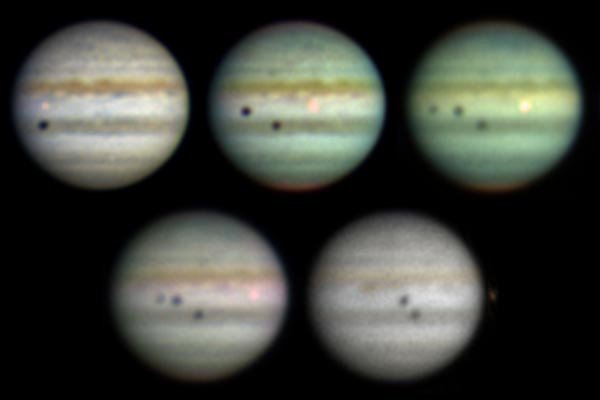
“Part of Jupiter is missing. Actually, three parts appear to be missing. In reality though, the three dark spots seen in the above photograph are only shadows. The unusual alignment of three of Jupiter's moons between the Jovian giant and the Sun was imaged last November 10th. The shadows of Io, Callisto, and Ganymede move across Jupiter as these moons progress in their orbits. It was by noting the times of eclipse of Jupiter's moons in 1675 that Ole Roemer became the first person to measure the speed of light. When a shadow from Earth's Moon crosses the Earth's surface, the people inside the shadow see an eclipse of the Sun."
Copyright: Public domain
#960 A Magellanic Mural February 03, 1998
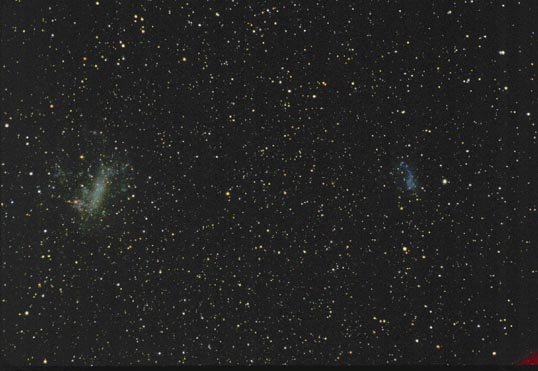
“Two galaxies stand out to casual observers in Earth's Southern Hemisphere: the Large Magellanic Cloud (LMC) and the Small Magellanic Cloud (SMC). These irregular galaxies are two of the closest galaxies to our Milky Way Galaxy. Recent observations of the LMC (on the left) have determined that it is on a nearly circular orbit around our Galaxy, and have even helped in the determination of the composition of dark matter in our Galaxy. The above photograph spans 40 degrees. Visible on the lower left of the LMC is the Tarantula Nebula (in red). In the foreground to the right of the SMC is globular cluster 47 Tucanae, appearing here as a bright point of light."
Copyright: Public domain
#961 A Passing Spaceship Views Earth February 04, 1998
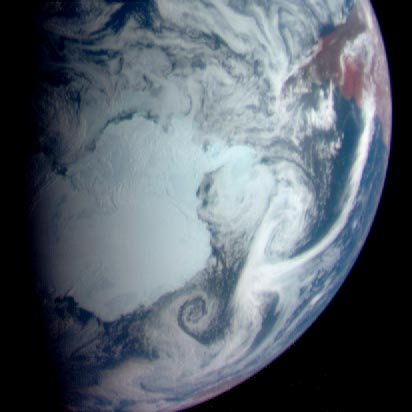
“This is how Earth appeared to the passing spacecraft NEAR. The Near Earth Asteroid Rendezvous (NEAR) spacecraft was launched from Florida, USA, planet Earth in 1996. After a quick flyby of asteroid Mathilde in June last year, NEAR passed the Earth two weeks ago on its way to asteroid 433 Eros. Visible on the above representative-color picture is the western part of Earth's Southern Hemisphere. Prominent features include the white snow-covered Antarctica and swirling and extended cloud systems. Oceans appear blue and part of South America is visible on the right."
Copyright: Public domain
#962 A Martian River Bed? February 05, 1998
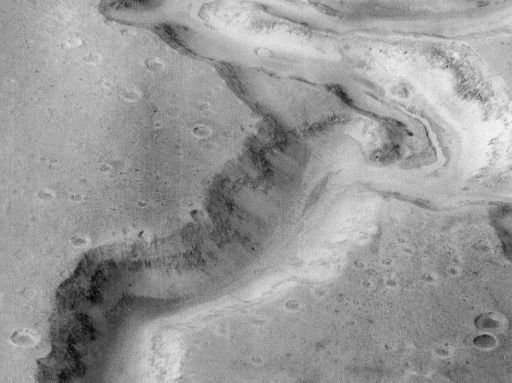
“This canyon on the surface of Mars appears to have been carved by flowing water. Known as Nanedi Vallis, the terraces and channels visible within the canyon strongly suggest that a river of water once ran here. But the lack of smaller surface channels and other features argue that the valley was formed by a surface collapse. Further images of Martian valley systems will help distinguish the degree to which these processes affected the Martian surface. This image was recorded on January 8th by the Mars Global Surveyor's camera during its 87th orbit of the red planet. The area pictured is about 6 miles wide. High resolution versions of the image show features that are as small as 40 feet across."
Copyright: Public domain
#963 Happy Birthday Jules Verne February 06, 1998
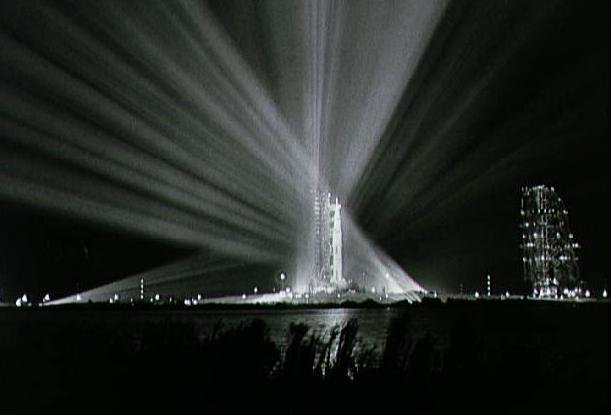
“Sunday marks the 170th anniversary of the birth of Jules Verne (born in Nantes, France on the 8th of February, 1828). Inspired by a lifelong fascination with machines, Verne wrote visionary works about "Extraordinary Voyages" including such terrestrial travels as Around the World in 80 Days, Journey to the Centre of the Earth, and Twenty Thousand Leagues Under the Sea. In 1865 he published the story of three adventurers who undertook a journey From the Earth to the Moon. Verne's characters rode a "projectile-vehicle" fired from a huge cannon constructed in Florida. Does that sound familiar? A century later, the Saturn V rocket and NASA's Apollo program finally turned this work of fiction into fact, propelling adventuresome trios on what was perhaps Verne's most extraordinary voyage. This stirring floodlit view shows the Apollo 9 space-vehicle atop its Saturn V. Launched from a spaceport in Florida in 1969, the Apollo 9 crew were the first to test all lunar landing hardware in space ."
Copyright: Public domain
#964 COBE Hotspots: The Oldest Structures Known February 07, 1998
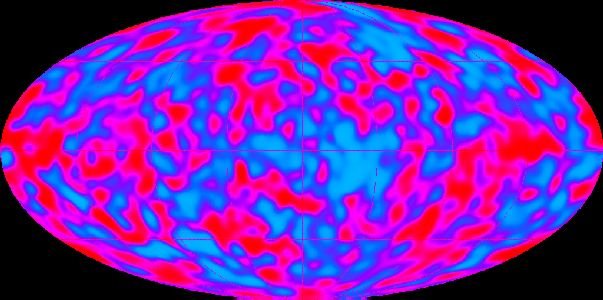
“Above is a microwave image of the entire sky. The plane of our galaxy runs horizontally through the center. This historic all-sky map is based on the first two years of data from NASA's COsmic Background Explorer (COBE) satellite. After computer processing to remove contributions from nearby objects and the effects of the earth's motion, the map shows temperature variations in the early Universe as red "spots". These spots are the oldest, most distant structures known. As our Universe expanded and cooled, conglomerations of mass formed. The COBE images confirm that only a million years after the big-bang - which occurred roughly 15 billion years ago - parts of the universe were visibly hotter than other parts. By studying the size and distribution of the spots found with COBE and future missions, astronomers hope to learn what matter and processes caused the spots to form - and hence determine the composition, density, and future of our Universe."
Copyright: Public domain
#965 M1: Filaments of the Crab Nebula February 08, 1998
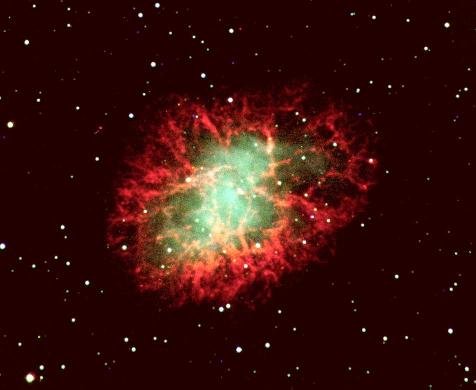
“The Crab Nebula, filled with mysterious filaments, is the result of a star that exploded in 1054 AD. This spectacular supernova explosion was recorded by Chinese and (quite probably) Anasazi Indian astronomers. The filaments are mysterious because they appear to have less mass than expelled in the original supernova and higher speed than expected from a free explosion. In the above picture, the color indicates what is happening to the electrons in different parts of the Crab Nebula. Red indicates the electrons are recombining with protons to form neutral hydrogen, while green indicates the electrons are whirling around the magnetic field of the inner nebula. In the nebula's very center lies a pulsar: a neutron star rotating, in this case, 30 times a second."
Copyright: S. Kohle, T. Credner et al.AIUB
#966 The Witch Head Nebula February 09, 1998
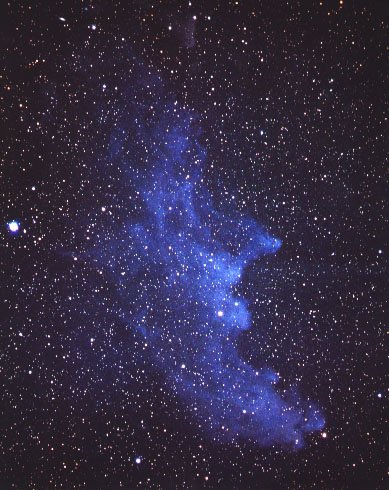
“Double, double toil and trouble; Fire burn, and cauldron bubble ... Maybe Macbeth should have consulted the Witch Head Nebula. This suggestively shaped reflection nebula is associated with the bright star Rigel in the constellation Orion. More formally known as IC 2118, the Witch Head Nebula glows primarily by light reflected from Rigel. Rigel is located about one photo-width off the image to the right. Fine dust in the nebula reflects the light. The blue color is caused not only by Rigel's blue color but because the dust grains reflect blue light more efficiently than red. The same physical process causes Earth's daytime sky to appear blue, although the scatterers here are molecules of nitrogen and oxygen. The nebula lies about 1000 light-years away."
Copyright: G. Greaney
#967 All of Mars February 10, 1998
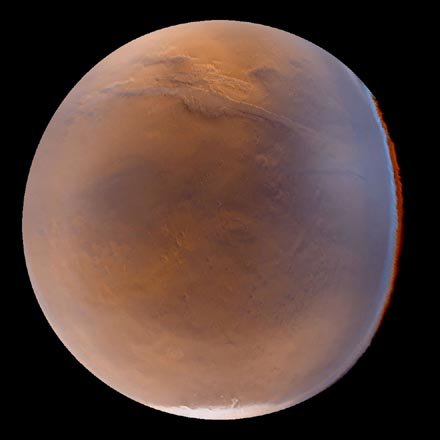
“Mars Global Surveyor is photographing Mars. The robot spacecraft arrived last September and continues to use solar panel aerobraking to help maneuver it to a better orbit to survey all of Mars The above image is a reconstruction of several photographs digitally combined to simulate a single vantage point 2700 kilometers above the Martian surface. The images were taken by the Mars Orbital Camera in wide angle mode in late December 1997. Visible features include the Valles Marineris canyon across the top, and the South Polar Cap of frozen carbon dioxide at the bottom. Many finer features that would normally be visible are hidden by dust remaining from a planet-wide storm that subsided only three weeks before these images were recorded."
Copyright: Public domain
Upvote! Resteem! Comment! As you like it! Thank you for attention!